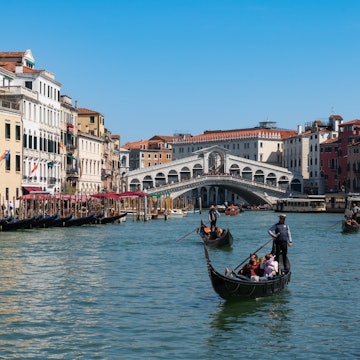

Browsing Vienna’s annual Christmas market with a mulled wine is a quintessential Austria experience © posztos / Shutterstock
Mountainous landscapes, legendary road trips and vibrant yet prestigious cities await in Austria, a landlocked country in the heart of Europe. For a relatively small nation, Austria offers so much, whether you're looking for great outdoor activities, immersive cultural experiences – or both.
Weather patterns are shifting, but April and November tend to be the wettest months, while temperatures are lowest in January and climb highest in July. May and September usually offer the most pleasant conditions.
Have skiing, hiking or a city trip in mind? Time your trip to Austria perfectly with our guide.
May to June and September to October are best for hiking
Looking to tackle a hiking adventure in the Austrian Alps? Plan your outdoorsy trip in May, June, September or October. Temperatures are modest, with a maximum of around 30°C (86°F) in the valley and cooler when you reach altitude. Another bonus is that the sun is up early and days on the trail can be longer. Some high-altitude regions may still/already be covered in snow, so check live cams where available. Find up-to-date weather information and warnings for several mountain regions in Austria at ZAMG (currently only available in German, but you can use the auto-translate tool in your browser).
During these months, you can expect to get good deals on hotels and alpine huts. But keep public holidays in mind, especially in May and on October 26 (Austria’s national holiday), when accommodations, highways and trains tend to fill up quickly.

July and August are best for swimming
Summers in Austria can be sweltering, and many flock to the lakes on the weekends – or even after work. Cooling off in the lakes or even in rivers like the Danube is a true delight in July and August. Water temperatures vary but you can expect pleasant dips in the likes of Wolfgangsee, Wörthersee and Attersee during the summer months.
It usually cools down at night, but there have been some pretty hot nights in recent years. Be aware that houses and apartments are not often equipped with AC, but most hotels usually are. Bear this in mind when choosing accommodation.
Avoid cities like Vienna and Salzburg in July and August
Plan any trips to major cities like Vienna, Salzburg and Innsbruck in the shoulder season. The sun and crowds become unbearable in these cities in summer, and tickets to major sites sell out quickly. You’ll experience a more authentic version of Austria and have a more enjoyable experience if you opt for April, May, September or October.
If you do happen to find yourself in the cities in summer, start your days early (before 8am) to wander empty streets without the crowds.

September and October are best for wine trips
When temperatures start to cool and the leaves shake off their bright green hue in favor of autumnal glory, it’s the best time to visit the wine regions of Austria. Head to Wachau in Lower Austria and the South of Styria to enjoy a savory Brettljause (platter of cold cuts of local meats and cheeses, served with farmhouse bread), wine and Sturm (seasonal fermenting grape juice) at a Heuriger or Buschenschank (small, locally-run restaurants or wine taverns).

Mid-December to mid-March is best for skiing and snow
Winter sports enthusiasts – particularly those into skiing and snowboarding – should plan their trip to the Alps for mid-December to mid-March. Accommodation prices skyrocket during the two-week Christmas holiday and school holidays in February. Go in mid-January or March instead and enjoy the ski resorts with fewer crowds in Salzburg, Tyrol, Carinthia, Vorarlberg or Styria.
For a taste of winter outside of these months, check out the region's glaciers – including the one in Hintertux, which is open year-round.
Mid-November till early January for Christmas markets
Traditionally, most Christmas markets in Austria open on the first weekend of Advent, which is usually early December. This has changed slightly in recent years. The Christkindlmarkt at Vienna’s City Hall opens in mid-November and closes after the Christmas holidays. Sternadvent in Salzburg is one of those that remain open the longest, until early January. Plan ahead and book your accommodation in advance to secure a good deal. Ideally, opt for Christmas markets that you can reach by public transportation, so you can enjoy a hot mug of mulled wine or two.
Experience Austria’s cultural side year-round
Austria is exciting every day of the year. Whether it's Easter processions in Tyrol or Styria, spring festivals like Narzissenfest or Steiermark-Frühling, the world-renowned Salzburger Festspiele in summer, cattle processions in the Alps in autumn or unique and sometimes odd Christmas traditions such as Krampus or Perchten in December, you’ll be able to create an outstanding itinerary full of memorable moments – no matter when you decide to visit.
Planning a trip to Austria? Here's more of our expert advice:
Read our best tips for getting around in Austria
Don't miss the best things to do in Austria
These destinations should be on your itinerary
















